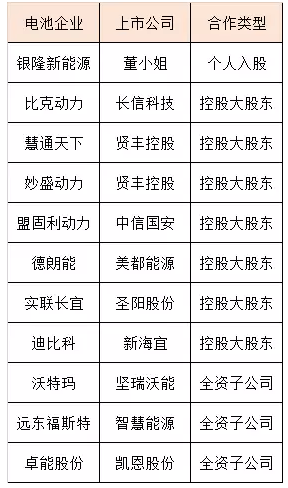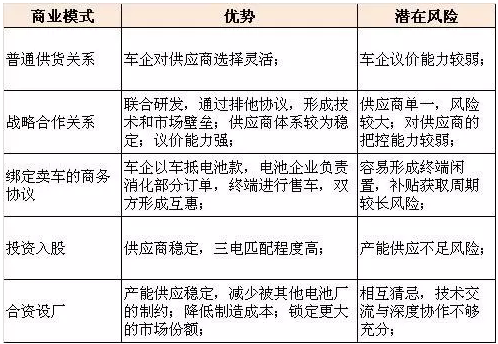Any market competition is ultimately a battle for business models.
The preliminary review of commercial power battery companies by Ligong Lithium has revealed that there are four main types of business models, including cooperation between power battery companies and OEMs, capital cooperation with listed companies, and alliances with industrial chain companies, and BYD as the representative. The whole industrial chain layout model.
Specifically, the above four business models include:
First, the whole industry chain layout model. The competition in the power battery market is moving from the 1.0 era of singles to the 2.0 era of collaborative warfare. However, taking itself as the starting point, the vertical layout of the upstream and downstream whole industry chain continues to be an important way for power battery companies to expand their own development.
The second is the capital cooperation business model between power battery companies and listed companies. Power battery companies are facing capacity increase, technology upgrades, cost reductions, and huge financial pressure. Which seek to cooperate with listed companies, whether it is a capital share, or directly acquired, have become a shortcut for many battery companies to quickly finance.
The third is the “marriage†model between power battery companies and automakers. At present, the new energy auto industry is facing multiple pressures such as subsidy retreat, longer billing period, rising prices of raw materials, and increased mileage. Power battery companies are in urgent need of reaching deep-binding cooperation with automakers to seek breakthroughs in technology upgrading, cost reduction, and market share lock-in.
The fourth is the alliance model. Under the premise of relatively weak individual strength, battery companies adopt Lianheng industrial chain and other companies to negotiate with customers, government and other entities in the form of a group. They can conduct business quickly in a short period of time, and receive the support of suppliers to break through in the market competition. A new world.
According to the respective characteristics of the power battery companies, Gaogong Lithium Power specially selected four typical power battery companies BYD, Ningde times, Yinlong New Energy, and Waterma layout, in order to benefit readers.
BYD full industrial chain layout model
The first model is based on the business model represented by BYD, the industrial chain from the mineral resources of the front-end upstream, to the manufacture and operation of the vehicle, and finally to the recycling of the battery, forming a "lithium resource from the upstream - lithium raw materials - The whole industrial chain of power battery—new energy vehicle—battery recycling is closed.
In order to adapt to the development of market-oriented competition, BYD's power battery business has been closed and open to the outside world. It will be supplied to all vehicle manufacturers, and auto parts will also be purchased globally. Industry insiders generally believe that BYD's battery supply to the outside world will significantly change the pattern of China and global power battery market.
In fact, the layout of the entire industry chain is conducive to the formation of closed-loop industrial enterprises, to play an overall advantage, reduce costs. However, the requirements for the company's capital, technology, scale, and forward-looking layout strategy are relatively high. At present, companies including Xingneng Group, CITIC Guoan Group, and Lions Science and Technology are also actively expanding the layout of the entire industry chain.
Yinlong New Energy + Miss Dong
The second kind of power battery companies choose to cooperate with the capital business model: The former is a wholly-owned subsidiary of a listed company and a listed company is a battery-holding company. Among them, Dong Mingzhu joined forces with Wang Jianlin and Liu Qiangdong to share Yinlong New Energy as a unique case in the latter.
According to the company’s public information, Gaogong Lithium Electric ran a number of cases concerning power battery companies and capital cooperation. According to the following table, there were many cases of listed companies’ capital increase and share participation. Among them, Yinlong New Energy and Miss Dong and Gree Electric Co. People are concerned.

Yinlong New Energy has attracted so much attention because of three main reasons: First, Dong Mingzhu is a self-proclaimed aura of well-known entrepreneurs in China; Second, Yinlong New Energy insists on lithium titanate battery technology; Third, Yinlong New Energy. After being handed over with Miss Dong, she was frequently deployed throughout the country.
Simple combing, Yinlong New Energy's layout after Miss Dong:
During the period from July 28, 2017 to December 16, 2016, Yinlong New Energy's investment in various regions accelerated, and the industrial parks were successively constructed in Zhuhai, Nanjing, Lanzhou, Chengdu, and Tianjin, with a total investment of more than 30 billion yuan. According to news, the Changsha base is also being planned, and its production capacity in Hefei, Anhui Province has also been finalized.
At the same time, on July 26 this year, according to the website of the Nanjing SASAC, the signing ceremony of Yinlong New Energy's acquisition of the Nanjing Bus Factory Co., Ltd. framework agreement has been held.
Ningde era and SAIC "marriage" model
The third model is a "marriage" between the battery factory represented by the Ningde era and SAIC and the vehicle manufacturer. At present, the power battery market has entered rapid development. On the one hand, car companies are more and more eager to control power batteries. On the other hand, power battery companies also need to bind customers to lock market share. Therefore, the cooperation between car companies and power battery companies has also progressed rapidly.
According to the statistics of Ligong Lithium Grid, in addition to the Ningde era and SAIC, the current battery factory and OEM cooperation cases include: Guoxuan Hi-Tech and BAIC, Yinlong New Energy and China Motors Times, Boston Battery and Land Local Boat, FAW Bus and Chunlan New Energy, Yutong Bus and Ningde Times, Dongfeng Automobile and Ningde Times, Guoneng Automobile and Ningde Times, Tangjun Automobile and Camel Shares, etc.
Specifically, the business model of cooperation between car companies and power battery companies can be divided into general supply relationships, strategic cooperation relationships, business agreements that bind and assist car sales, investment in battery manufacturers, or joint ventures with battery manufacturers.
It is worth mentioning that the advantages and potential risks of the above-mentioned several commercial cooperation models coexist. The Institute of Lithium Research Institute of Lithium-Electric Power (GGII) has made the following analysis of the various cooperation modes existing between battery companies and vehicle manufacturers:

Watermark Alliance model
The fourth model is typical of Waterma. With its own power battery business, Watermar forms a coalition with upstream and downstream companies in the industrial chain. Up to now, there are more than 1,000 member companies in the Wuppertal Alliance. Through the company's team, Wattmar negotiates with the government and the client by virtue of its status as a coalition to gain its own appreciation space.
In the first half of 2017, Gordon’s lithium combed Wattmar orders and found that backed by the Baotou Alliance model, as of August 7th, Wattham & Rongcheng Huatai Automobile, Hubei Century Zhongyuan, Tang Junou Bell, Chengdu Dayun, Dongfeng Special Steam , Shanghai Shenlong Bus, Anhui Xingkailong Bus and other automakers signed orders totaling more than 10.3 billion yuan.
At the same time, in order to fully protect its product supply, Watermar has already put into operation seven power battery production bases in Shenzhen, Weinan, Linyi, Shiyan, Quzhou, etc. It is expected that by the end of 2017, the production capacity of Wotema's power batteries will reach 20GWh.
TITANIUM HEAT EXCHANGERS
In chemical processes, the use of Titanium Heat Exchangers has been found to be a cost-effective method of resisting leaks from corrosion on a process line. The following information provides additional background on Titanium, its characteristics, strengths, and how a Titanium Heat Exchanger could be the answer to corrosion in your system.
Life Cycle Benefits of Titanium Heat Exchangers
Titanium Heat Exchangers are highly cost-effective over the entire life cycle of the equipment. Properly maintained, Titanium Heat Exchangers can operate for decades, making them a very economical choice.
Titanium Heat Exchangers can:
Provide an extended service life compared to other materials of construction
Eliminate expensive downtime due to equipment failure
Do away with requirement for spare parts inventory
Provide superior corrosion resistance
Deliver high heat transfer efficiency
Accommodate high steam pressure to reduce required surface area
Eliminate breakage during handling, installation and operation due to fully-welded metal construction
Titanium the Metal
Titanium is one of several metals which fall into the category of reactive metals or corrosion resistant alloys (CRAs). Reducing or oxidizing environments, with or without chlorides, and temperatures up to 1200°F, are all possible with this group of exceptional materials. In addition to high resistance to uniform corrosion attack, CRAs can be very successful against pitting, crevice and stress corrosion.
Titanium is used as the material of construction for Heat Exchangers in chemical, petrochemical, oil & gas and other industrial manufacturing environments. In these processes, aggressive fluids, often at very high temperature and or pressure, come into contact with equipment surfaces, testing the strength and corrosion resistance of the material.
Considered the workhorse of the reactive metals, Titanium is readily available. More Titanium goes into corrosion-resistant equipment fabrication than all other reactive metals combined. Please see Applications of Titanium for a more in depth look at additional uses for Titanium that includes some comparative corrosion resistance data, media, concentrations and temperatures.
Titanium Heat Exchanger Designs
TITAN offers a full range of TEMA-type Titanium Heat Exchangers. Utilizing both HTRI and AspenTech thermal design software, we can custom design a Heat Exchanger to fit your application. TITAN`s Heat Exchanger designs take advantage of loose-lined, solid, and explosive clad tube sheet options based on the mechanical demands of the application.
TITAN manufactures pressure equipment in accordance with all major international design standards and pressure vessel codes.
Titanium Corrosion Resistance
TITAN Titanium Heat Exchangers are used in a wide variety of environments. To view a list of materials where Titanium is commonly used, please visit Applications of Titanium.
Titanium Fabrications
In addition to Titanium Heat Exchangers, TITAN regularly designs, engineers and fabricates the following types of Titanium custom process equipment:
Titanium Columns and Towers
Titanium Pressure Vessels
Titanium Reactors
Titanium Spargers
Titanium Pipe
Titanium Piping Systems
Titanium Heat Exchanger,Titanium Plate Heat Exchanger,Exchanger Titanium Aquarium,Titanium Tube Heat Exchanger
Liaoning LotusNine International Trade co.,ltd , https://www.lj-heatexchangers.com